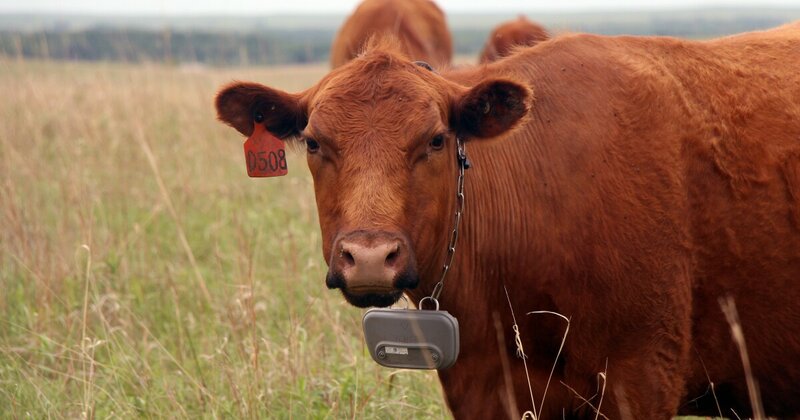Posted on Jun 21, 2022
How satellite-guided cows might save the Kansas prairie and make ranchers more money
1.23K
34
6
11
11
0
Posted 2 y ago
Responses: 4
PO1 William "Chip" Nagel
SFC Joe S. Davis Jr., MSM, DSL Bloody Amazing what they're doing in Ranching these days.
(1)
(0)
PO1 William "Chip" Nagel
..."How the collars work
The Mushrush ranch is home to between 800 and a couple thousand cattle, depending on the time of year. The family owns or leases about 15,000 acres.
Seen on a map, the ranch is shaped something like Africa. Fencing, meanwhile, cuts across it in straight lines.
“That’s where it was drawn out 100 years ago,” Mushrush said. “That’s where the fence is yet today.”
Those rigid lines are blind to the curvy contours that shape this land — flat-topped hills, rocky ledges and snake-like, meandering streams.
Yet when it comes to grazing, the contours matter. They effectively funnel cattle toward some areas and away from others.
And when the herd consistently opts, say, to lounge along a creek, the damage can add up. The cattle can chomp and stomp the same areas too much, tearing up the banks and filling the stream with nitrogen from their manure.
Mushrush decided to try the GPS collars. His barbed wire fences just aren’t where he needs them, making it hard to give vegetation the right balance of grazing and rest that produces more robust grasses.
When grasses suffer, it limits how many animals a ranch can support.
Mushrush can’t solve the problem by installing ever more physical fences, which can cost thousands of dollars per mile. Even with temporary fences, it’s tough. This landscape — including when any given swath of it would benefit from more or less grazing — is simply too nuanced.
Virtual fence aims to let ranchers block off any zone on their property by pulling up a map on an electronic tablet and using software to set the lines.
Adding a buffer zone along a winding creek — practically impossible, and prohibitively expensive with normal fences — becomes easy. So do other changes, such as redrawing paddocks or moving cattle to let grazed grasses grow.
The GPS collars don’t require ranchers to bury wires in the ground the way invisible fences for dogs frequently do.
If cattle walk toward the invisible line, the collars make noises. If they keep walking, those noises get louder. If they cross the line, the collars deliver a shock.
Most of the cattle take the hint. A few shrug off the discomfort and cross the barrier to munch on the proverbial greener grass.
But if most of the cattle stick to the rules, that could be enough to benefit ranchers, flora and fauna."...
..."How the collars work
The Mushrush ranch is home to between 800 and a couple thousand cattle, depending on the time of year. The family owns or leases about 15,000 acres.
Seen on a map, the ranch is shaped something like Africa. Fencing, meanwhile, cuts across it in straight lines.
“That’s where it was drawn out 100 years ago,” Mushrush said. “That’s where the fence is yet today.”
Those rigid lines are blind to the curvy contours that shape this land — flat-topped hills, rocky ledges and snake-like, meandering streams.
Yet when it comes to grazing, the contours matter. They effectively funnel cattle toward some areas and away from others.
And when the herd consistently opts, say, to lounge along a creek, the damage can add up. The cattle can chomp and stomp the same areas too much, tearing up the banks and filling the stream with nitrogen from their manure.
Mushrush decided to try the GPS collars. His barbed wire fences just aren’t where he needs them, making it hard to give vegetation the right balance of grazing and rest that produces more robust grasses.
When grasses suffer, it limits how many animals a ranch can support.
Mushrush can’t solve the problem by installing ever more physical fences, which can cost thousands of dollars per mile. Even with temporary fences, it’s tough. This landscape — including when any given swath of it would benefit from more or less grazing — is simply too nuanced.
Virtual fence aims to let ranchers block off any zone on their property by pulling up a map on an electronic tablet and using software to set the lines.
Adding a buffer zone along a winding creek — practically impossible, and prohibitively expensive with normal fences — becomes easy. So do other changes, such as redrawing paddocks or moving cattle to let grazed grasses grow.
The GPS collars don’t require ranchers to bury wires in the ground the way invisible fences for dogs frequently do.
If cattle walk toward the invisible line, the collars make noises. If they keep walking, those noises get louder. If they cross the line, the collars deliver a shock.
Most of the cattle take the hint. A few shrug off the discomfort and cross the barrier to munch on the proverbial greener grass.
But if most of the cattle stick to the rules, that could be enough to benefit ranchers, flora and fauna."...
(6)
(0)
PO1 William "Chip" Nagel Very interesting means of maintaining grazing range! If the electric shock is a strong as I remember from our electric fence, those cattle will learn quickly!
(5)
(0)
PO1 William "Chip" Nagel
CSM Charles Hayden We had an "Electric Fence" for One of Our Dogs "Bud" He was an Escape Artist from Hell, I Touched It Once! Don't Do that! It Hurts!
(2)
(0)
Read This Next



 Ranching
Ranching Technology
Technology Wildlife
Wildlife Science
Science GPS
GPS


